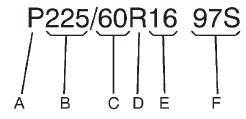Tire Designations
Tire Size
The following is an example of a typical passenger vehicle tire size.

(A) Passenger (P-Metric) Tire:
The United States version of a metric tire sizing system.
The letter P as the first character in the tire size means a passenger vehicle tire engineered to standards set by the U.S. Tire and Rim Association.
(B) Tire Width: The three-digit number indicates the tire section width in millimeters from sidewall to sidewall.
(C) Aspect Ratio: A two-digit number that indicates the tire height-to-width measurements.
For example, if the tire size aspect ratio is 60, as shown in item C of the illustration, it would mean that the tire's sidewall is 60 percent as high as it is wide.
(D) Construction Code:
A letter code is used to indicate the type of ply construction in the tire. The letter R means radial ply construction; the letter D means diagonal or bias ply construction; and the letter B means belted-bias ply construction.
(E) Rim Diameter: Diameter of the wheel in inches.
(F) Service Description:
These characters represent the load index and speed rating of the tire. The load index represents the load carrying capacity a tire is certified to carry. The speed rating is the maximum speed a tire is certified to carry a load.
See also:
Reactivation for Subsequent Owners
Push and follow the prompts to speak to an Advisor as soon as possible after acquiring the vehicle.
The Advisor will update vehicle records and will explain the OnStar service offers and options ava ...
How to Check Lubricant
2500HD with 6.0 L
All Other Series and Engines
To get an accurate reading, the vehicle should be on a level surface.
• For all 4.3 L, 4.8 L and 5.3 L 1500 Series applications, the proper leve ...
Hoses
Hoses transport fluids and should be regularly inspected to ensure that there are no cracks or leaks.
With a multi-point inspection, your dealer can inspect the hoses and advise if replacement is nee ...





